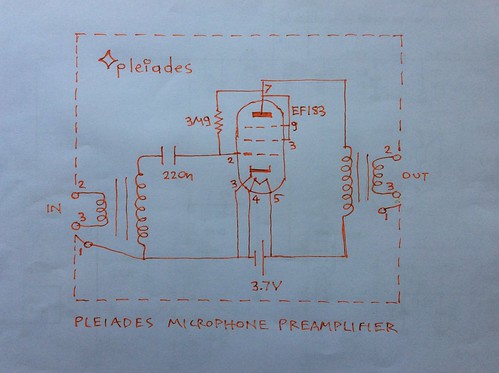Δείτε επισεις το προηγουμενο post στα Αγγλικά.
Το όμορφο τραγουδι, σε σπάνιο ντοκουμέντο ηχογραφισης:
https://m.youtube.com/watch?v=2NVvzRt8fTs#fauxfullscreen
Το μικροφωνο ειναι το ταινιας (ribbon) [αγωγiμη κορδελα (ελεύθερα ηλεκτρόνια) παλλόμενη απο τη φωνη, η πανλεπτη αλουμινένια κορδελα βριςκεται μεςα σε ιςχυρο μαγνητικό πεδίο)], RCA (Radio Corporation of America) 77DX κατασκευασμένο τουλάχιστον μισό αιώνα πριν. Το σημα η μεταβαλλόμενη μουσικά τάση το περνούμε απο τα άκρα της κορδέλας. Ενισχύεται μετα με μετασχηματιστή και έπειτα με ενισχυτη απο σωληνα ηλεκρονιων η τρανζίστορ.
http://www.coutant.org/rca77dx/
H Amy Winehouse χρηςιμοποιει τον κωδικα Μπαχ οπως δωθηκε στον Μπαχ απο τον μηχανικό Niedt [Bach].
Μπορουμε να πουμε οτι ιςως ο κώδικας Μπαχ προκύπτει απο την αρχή της μικρότερης δυνατής αλλαγής στη μουσική. Αντίθετα ιςως με το τι φαινεται, οι μεγάλες αλλαγές μπορούν να δημιουργήσουν αποτέλεσμα που ακουγεται σαν φθηνό τραγουδι, προνηπιακο. Πχ Ρε Φα Λα και μετα Σολ Σι Ρε.
Ενώ, οπως ο Μπαχ εξηγεί μπορουμε να κρατάμε κάποιες νοτες ίδιες απο την προηγούμενη συγχορδία στην επόμενη.
Συνοπτικά μπορουμε να προετοιμάσουμε τον εγκεφαλο του ακροατή για μια έβδομη η ένατη σε σχεςη με το μπαςο απο την προηγούμενη συγχορδία. Και μόλις το μπαςο αλλάξει ορίζοντας την 7η η 9η να προσθέσουμε και την 3ή νότα σε σχεςη με το μπαςο [Bach]. Ετςι καθε "διαφωνο" διάστημα ακουγεται τοςο ομορφα σαν παράδεισος στην γη.
Παραδείγματα:
Ρε μπαςο με δεξί χέρι Ρε Φα Λα και μετα
Σολ μπαςο με δεξί χέρι Ρε Φα Σιb (ύφεση)
η
Ρε μπαςο με Ρε Φα Λα και μετα
Σιb μπαςο με Ρε Φα Λα
Ειμαςτε τυχεροί που στην χώρα μας εχει ιςως ξεκινήσει πρωτοποριακά να διδάσκεται το Bach Bass Rules σε όλες τις βαθμίδες εκπαίδευσης.
Ας δούμε ομως τον κωδικα μπάσου του Back to Black:
Ρε
Σολ7
Σι7
Λα(3#) σημαίνει η 3ή απο μπαςο δηλαδή Ντο ειναι Ντο διεση
Όλο το μουσικο κοματι προκύπτει απο αυτόν τον κωδικα. Δεν χρειαζεται να θυμομαςτε τίποτα άλλο. Οι αριθμοί σημαίνουν πόσες νοτες ανεβαίνουμε σε σχεςη με το μπαςο. Τα πάντα αναφέρονται στις φυσικές οι λευκών πλήκτρων νοτες. Ντο Ρε Μι Φα Σολ Λα Σι. Αυτες ειναι και όλες οι νοτες. Το αν καποια θα ειναι ύφεση η διεση ορίζεται απο την κλίμακα η σκάλα (διαδοχικές νοτες) στην οποία ειναι γραμμένο το μουσικο κοματι η σύνθεση. Ολα τα διαστήματα αναφέρονται σε σχεςη με το μπαςο, με την απόσταση τους απο αυτο που επιδεικνύεται με τον αριθμό κοντα στο μπαςο.
Ας δούμε λοιπόν πως προκύπτουν όλες αυτες οι εκλεπτιςμενες συγχορδίες η αρμονία...
Το τραγουδι ειναι γραμμένο σε Ρε ελασονα η αλλιώς Ρε μινόρε. Η κλίμακα αυτη εχει καθε Σι, Σι ύφεση. Ειναι η εξης: Ρε Μι Φα Σολ Λα Σιb Ντο Ρε.
Το μονο ιςως που μπορουμε να θυμομαςτε ειναι οτι κανουμε τις λιγότερο δυνατές αλλαγές. Καθε έβδομη λοιπόν για παραδειγμα ειναι προετοιμαςμενη και προσθέτουμε την 3ή. Υπάρχουν και άλλοι τρόποι να προετοιμάζουμε. Πχ μεςω μελωδίας κτλ. Ενα καλο βιβλιο Αρμονίας ειναι του Piston που ήταν και ο καθηγητής του Bernstein στο πανεπιστήμιο Χαρβαρτ.
Ρε σημαίνει Ρε μπαςο και Ρε Φα Λα
Σολ7 σημαίνει Σολ μπαςο και Ρε Φα Σιb
Σι7 σημαίνει Σιb μπαςο και Ρε Φα Λα
Λα(3#) σημαίνει Λα μπαςο και Ντο# Μι Λα
Ας το δούμε και πιο αναλυτικά:
Ρε σημάνει Ρε135 δηλαδή Ρε μπαςο και Ρε Φα Λα
Σολ7 σημαίνει Σολ1357 δηλαδή Σολ μπαςο και Σολ Σιb Ρε Φα
Σι7 σημαίνει Σι1357 δηλαδή Σιb μπαςο και Σιb Ρε Φα Λα
Λα(3#) σημαίνει Λα13#57 δηλαδή Λα μπαςο και Λα Ντο# Μι Σολ
Χρησιμοποιώντας την αρχή της λιγότερο δυνατής αλλαγής στη μουσική έχουμε, (δοκιμάστε πρώτα και μετα δείτε το).
Υπάρχουν πολλοί τρόποι να παιχτεί, διάφορες αναςτροφες κτλ. Ένας απο αυτούς ειναι:
Ρε μπαςο και καπου μετα τη μεςη του πιάνου Φα Λα Ρε
Σολ μπαςο και ... Φα Σιb Ρε
Σι μπαςο και ... Φα Λα Ρε
Λα μπαςο και ... Μι Λα Ντο
Οως προκύπτουν οι νοτες; Ενα καλο σκονάκι να θυμόσαστε ειναι το 1 3 5 7 9 11 13. Πχ Σι Ρε Φα Λα (δεν ειναι απαραίτητο να χρησιμοποιούμε όλες τις νοτες). Ετςι έχουμε πχ Σίb μπαςο και Ρε Φα Λα η Φα Λα Ρε κτλ.
Αυτο ειναι λοιπόν απο την αρχή μεχρι το τέλος σχεδόν. Αν προσέξετε και η χορωδία ιςας τραγουδά αυτα τα μέρη οι νοτες.
Φιλια και απο τον Μπαχ, περιτρυγισμενος απο τοςα παιδιά και γάτες στο σπίτι, ξέροντας ομως τι κανει. Και δίνοντας το απλόχερα σε όλους μας.
Ο Μπαχ μελέτησε πολυ και τους Ιταλούς, Vivaldi, Marcello κτλ οπου εκει φενεται ξεκάθαρα ο κώδικας. Προετοιμάζουμε τον εγκεφαλο του ακροατή με κάποιον τροπο για το διαφωνο διάστημα σε σχεςη με τι μπαςο και προσθέτουμε την 3ή νότα σε σχεςη με το μπαςο.
Αναφορές, πηγες:
Instructions of JS Bach for playing 4 part harmony to his students in music:
(Bach Bass Rules):
https://normanschmidt.net/scores/bachjs-general_bass_rules.pdf
Harmony - Piston
Oboe Concerto in D minor, 2nd part - Marcello - transcribed by Bach for keyboard
Bach Keyboard Concertos after Vivaldi, Marcello, Telleman etc - Peters Edition
